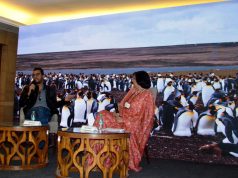 By INDU PANDE
By INDU PANDE
During the last five decades, there has been a paradigm change in international discourse on socio-economic development. While in the pre- Eighty era, the focus was on econocentric issues, simple economics of investment and outputs, the idea of sustainability in its wider dimensions alongside social and cultural environmental factors that got introduced in the development narrative. There has been a realization of importance of political factors in economic development.
Sustainability emerged as a compromise between Frontier Economics – an attitude of bash on regardless irrespective of environmental concerns and Deep Ecology – which professed an egalitarian approach where humans and all things sentient or insentient were placed on the same pedestal. Discarding the anthropocentric approach, it insisted on zero depreciation of natural capital.
It was a realization that, both, frontier economics as well as deep ecology were in themselves unsustainable. That’s where midway solutions like sustainable development and alternate technologies were developed.
The new discourse, accounted for a prudent and optimal use of natural, fiscal and human resources. It was also an acceptance of the view that the natural capital cannot be fully replaced by manmade capital. Resource assessment along with the best possible practical alternatives for resource use and utilisation efficiency assumed an important significance.
While the new generation economists introduced the idea of multiple dimensions of poverty like income poverty, educational poverty, shelter poverty and environmental poverty, etc., and lack of adequate political freedom, the solutions also became more complex. It’s not confined to eliminate income poverty but the wider dimensions of ever-expanding human development indices. Sustainable inclusive development with participation of various stakeholders was the new formula.
For a predominantly mountainous state of Uttarakhand, nestled in the Central Himalayas, the strategy for future development plans will have to factor in the environmental concerns and constraints along with balancing the needs of hitherto under-developed regions especially in the remote regions. Environmental mitigation measures become important along with raising the standards of living. Quantitative and qualitative aspects have to go together. We have to follow the definition of history which calls it a dialogue between the past and present addressed to the future. We must learn from the past and base our future strategies on the experience, amending it wherever necessary. Effective and efficient sustainable strategies which harmonise between the natural, fiscal and human resources to achieve optimum outcomes along with appropriate governance architecture should be the mantra for the future.
(Indu Kumar Pande is a retired civil servant).






